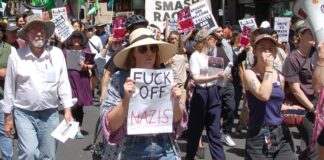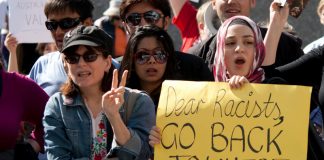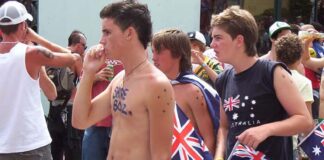The only regret from the New South Wales police over the Kings Cross shooting scandal seems to be that the incident was caught on camera.
NSW Police Union Chief Scott Weber complained to a Police Association meeting in May that, “It’s so easy to take a snippet and look at it in hindsight”. He complained police are “losing respect” on the street.
The now-famous footage shows police shooting at a car of unarmed Aboriginal joyriders on a street in Kings Cross, Sydney, and then beating them after the car stopped, issuing a series of savage blows to the head of one of the defenseless teenagers, whose blood covers the pavement.
After the footage made its way onto newspaper web sites around the world in April, the police went into damage control, leaking information to the media designed to smear the victims, saying one of the boys—at the time in a coma in hospital—had, “been in trouble with the police since he was eight.”
It’s not the first time the police in Australia have been rocked by a racist scandal. As we go to press, scenes of police violently breaking up the Aboriginal Tent Embassy in Musgrave Park, Brisbane, are all over the news. Racist and violent behaviour is perfectly ordinary in the police force.

Trained racists
Crime shows like NCIS, Law and Order or even Underbelly would have us believe the coppers are a benevolent force solving murders and keeping us safe.
Many rightly critical of police violence or racism see incidents like the Kings Cross shootings as an aberration, or the product of a few rotten apples. But these incidents happen all the time and police at every level are responsible. The only unique thing was that it was so widely publicised.
The primary role of police in society is to protect the property, power and privilege of those at the top of society from those at the bottom. Police are trained to defend the hierarchy of the class society we live in, and keep the young, working class, unemployed and in particular, those with black skin, at the bottom of it. Some of the most racist, sexist and homophobic ideas in society are found in concentrated form amongst police.
These ideas are used to justify inequality. There are higher levels of property crime among poor and marginalised communities, caused by poverty and desperation. But the job of the police is not to remedy the class inequality in society and begin to solve social problems. It is simply to repress and punish people. To justify this it suits them to believe the right-wing stereotypes that Aboriginal people, Arabs or Africans are “naturally” more likely to be involved in crime and go out of their way to racially target them and keep them “in their place”.
In 2010, the ABC revealed that Victorian police had been trained to racially profile African men. A PowerPoint slideshow used in police training stated that Sudanese youths were likely to be involved in, “anti-social behavior, armed robberies, alcohol, drugs and sexual assaults.”
Then, in 2010 a Victorian legal centre reported that when African youth had complained of police repeatedly stopping and searching them—and one group of young African men refused to submit to it—police returned later in plainclothes and beat them savagely.
The Age reported on May 4 that the practice of police bashings is extremely widespread. They revealed thousands of dollars has been paid out to immigrant youths to keep quiet about racist attacks on them by police.
The statistics reveal what the targeting of minority groups means. Aboriginal people are 14 times more likely to be locked up than non-Aboriginal people, and make up 24 per cent of the Australian prison population at the same time as constituting only 2 per cent of the population.
The rot starts at the top of the police force. What proves this decisively is the way police deal with accusations of racism—by protecting their own and sometimes, even rewarding them.
In 2010, police in Western Australia were caught on camera tasering an Aboriginal man, Kevin Spratt, 14 times. The officers involved were later promoted.
During 2006-2009, 20 young African men complained to the Victorian police about racist mistreatment. Only one investigation resulted—but the police subsequently charged several of the complaintants in what lawyers called “cover charges”.
Even the murderer of Mulrunji Doomadgee, Senior Sergeant Chris Hurley, was defended by his colleagues, who have admitted they lied to protect him. They nevertheless received bravery awards from the Queensland government for cracking down on protests demanding justice for Mulrunji. Hurley was promoted, awarded a $100,000 payout and now lives on the Gold Coast.
These racist attitudes mean police are worse than useless in preventing racism in society. When Indian students protested against a wave of racist attacks in 2009, the top cops of the Victorian Police force publicly blamed them for their situation. Victorian Deputy Police Commissioner Simon Overland encouraged students to “look as poor as you can” to avoid attacks, while the Deputy Police Commissioner said that Indian students were, “being attacked because they were by nature quiet and passive people, they travelled late at night, often alone, and carried expensive gadgets.”
The attitude of the police was starkly revealed at the time by an email, distributed to over 100 police, and leaked to the press. It showed a picture of an Indian person being electrocuted on a train with the caption, “This could be a way to solve the Indian student problem.”
The experience of implementing racist and unjust laws also strengthens bigoted ideas amongst police. For example, police in the Northern Territory implement alcohol prohibition laws against Aboriginal people which criminalise and stereotype Aboriginal drinkers.
In most workplaces, the experience of exploitation by management has the potential to draw workers into struggle against it and to challenge the racist ideas that divide people. But the police’s experience does not lead them into conflict with the boss, but with some of the poorest and most oppressed sections of society, who they must punish and blame for their situation.
Workers in uniform?
Some people refer to the police as “workers in uniform”, suggesting they are just like the rest of us. But no other workers have guns, tasers and the right to use violence. More than that, the police force is specifically used against all other workers.
The modern day police force came into existence in the UK during the struggle of the Chartists in the 19th century, a movement for working class rights and suffrage. The new ruling elite needed a force that could crack down on the Chartists and be relied upon to repress working class movements and dissent.
Police still play this role in society. Last year, the 14-day picket at the Baiada poultry factory in Melbourne was repeatedly attacked by police. Ever major strike has to face police breaking picket lines and bringing in strike-breakers.
Police are often rewarded for these actions to buy their loyalty. Just weeks after violently cracking down on Occupy Melbourne protests last year, police received a generous 4.7 per cent a year pay rise from Victorian Premier Ted Baillieu. Yet the nurses had to fight tooth and nail to the beat the 2.5 per cent pay cap imposed on everyone else in the public sector.
Police are the guard dogs a system based on racism and inequality. They are not neutral—they don’t investigate crimes of corporate greed, environmental destruction or hyper-exploitation at work. They crack down on those fighting it, and the poorest and most disadvantaged who suffer from it.
While an Aboriginal teenager lay in a coma for stealing a car, there is no compensation for generations of stolen land, stolen wages, or stolen children. The so-called New South Wales Police Integrity Commission won’t even investigate the Kings Cross shooting because, “they do not have the resources”.The whole incident should show one thing decisively—the real criminals wear uniforms.
Amy Thomas





